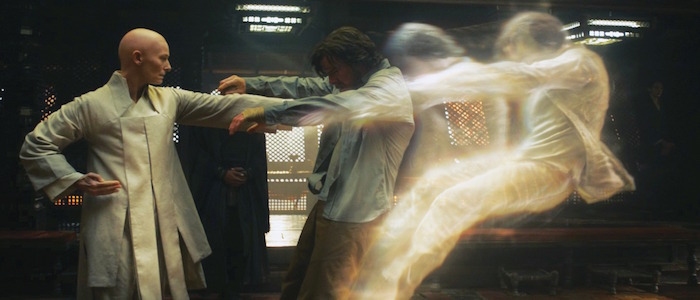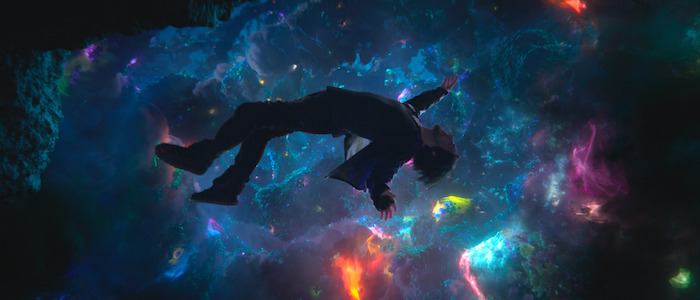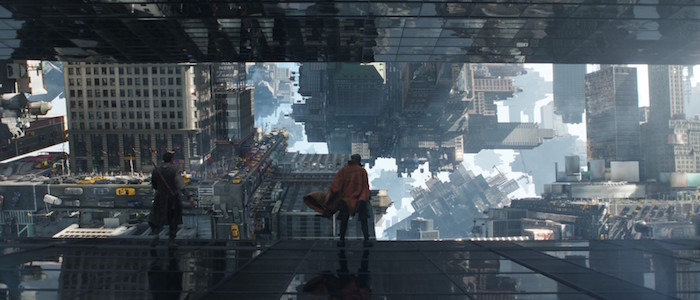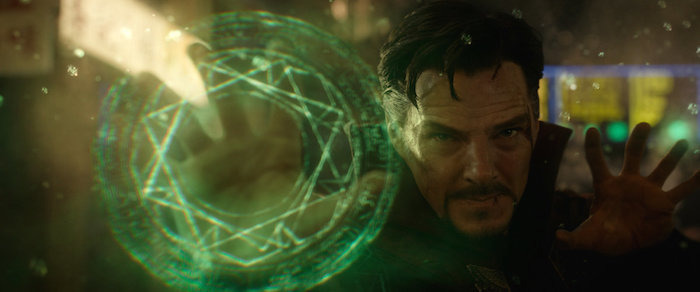'Doctor Strange' Opens Marvel's Mind And Expands Its Worldview
(Welcome to Road to Infinity War, a new series where we revisit the first 18 movies of the Marvel Cinematic Universe and ask "How did we get here?" In this edition: Marvel Studios enters bold new territory with Doctor Strange.)
In August of 2014, as Doctor Strange was being written and as Marvel was figuring out where to film it in 15 months time, the studio underwent a significant restructuring. Kevin Feige would no longer answer to Marvel CEO Ike Perlmutter, a notoriously fickle penny pincher and blockade to diversity, nor would Marvel Studios be subject to the Marvel Creative Committee, whose hellish process of studio-notes was a source of contention behind the scenes. Instead, Feige began answering directly to filmmaker-friendly Disney Charmian Alan Horn. Not long after, Marvel announced films like Black Panther and Captain Marvel and directors like Ryan Coogler (Creed) and Taika Waititi (What We Do in the Shadows) after only having had white men be the major focus on either side of the camera.
The message was clear. This was a whole new Marvel, and slowly but surely, the work began to reflect it.
Doctor Strange was already in pre-production by the time the shift happened, but the desire to bring the busy Benedict Cumberbatch on board in late 2014 necessitated a shift in schedule (the projected July 2016 released date was moved to November), a shift that may not have been possible under the previous regime. This allowed director Scott Derrickson more time to work on the script, but more importantly, it allowed him to bring his Sinister co-writer C. Robert Cargill on board the project (with previous drafts having been written by Jon Spaihts). This made it one of the first Marvel Studios films where the effects of moving out from under Marvel proper could likely be felt creatively.
Of course, the film wasn't without cultural controversy. Its whitewashing of an already complicated Tibetan Ancient One character has been addressed from all angles (including by the director himself) but it was Marvel's first step into a bigger world in other ways, outside of its previously American and Western defaults. The series had previously seen non-American settings from time to time, like Korea in Avengers: Age of Ultron and various vaguely Middle Eastern towns in the original Iron Man, but Doctor Strange felt like the beginning of a trend. Its shift in creative perspective continued with the likes of Thor: Ragnarok, Black Panther and arguably Guardians of the Galaxy Vol. 2 (more on that soon, dear readers!), where Marvel began to feel like a truly international franchise, bringing in ideas that felt postcolonial in their points of view rather than harping half-heartedly on American militarism.
Starting with Doctor Strange, Marvel began to go global.
The Western Hero
Stephen Strange has a complicated relationship to the typically Western paradigm of superhero/action storytelling. On one hand, he's part of a decades-old trope of orientalist erasure that centers white characters in Asian narratives, wherein the settings and secondary characters of colour serve as fodder for a white man's self-discovery. On the other, this particular incarnation of Strange works within that problematic and familiar structure to bridge a gap in narrative approach. Strange's initial reasons for traveling to Nepal involves a desire to master the physical. In this case it was bodily healing, though it's comparable to the mastery over physical combat seen in Batman Begins, Iron Fist, Arrow, The Last Samurai and countless other examples of white men traveling Eastward and becoming "chosen" figures.
In Doctor Strange however, Strange is immediately made to unlearn his narrative preconceptions, and pushed instead towards a form of spiritual harmony that exists distinctly beyond the physical.
The western super/action hero as it relates to these Eastern tales can be traced back to Manifest Destiny – through decades of cultural absorption if not direct intent. Whatever form these socio-political ideas of western individualism and American exceptionalism take in the real world, in a narrative context, they're often externalized as personal power rather than personal freedom. A form of domination born from self-determination, rather than harmony through self-actualization. Robert J. Miller lists the tenets of Manifest Destiny (as it relates to the historical conquering of Native Americans) as white Americans' belief in "special virtues of the American people and their institutions," their mission to "remake the world in the image of America" and most pertinently, "a divine destiny under God's direction" to accomplish the same.
And while few Western action stories adhere specifically to these tenets in a historical context, the idea of Manifest Destiny has bled into and influenced American storytelling for centuries, ingrained to the point of being a subconscious default. Even in Captain America: The Winter Soldier, arguably the best Marvel film up until this point, it's the white man draped in an American flag who defeats an evil empire through physical strength.
Countless stories from Rudyard Kipling's The Man Who Would Be King (1888) to all the way to Netflix's The Outsider (2018) feature narratives of white Westerners infiltrating, dominating and improving upon Eastern structures, while countless others tell similar tales even without Asian settings. Your average American action movie, including those in the Marvel saga, focus around an ethos and screenplay structure wherein "overcoming" a flaw is indecipherable from physically besting an opponent as a means to establish individual superiority. Iron Man shuts down his weapons manufacture, but his deal is finalized, dramatically speaking, when he punches a bigger Iron Man. The Hulk is stronger than The Abomination, Thor is stronger than Loki and Malekith, and even the Guardians of the Galaxy join hands to control the Power Stone, an externalization of physical strength, in order to vanquish Ronan. All justifiably so, dramaturgically speaking, but all within narratives that boil down to character arcs acting in tandem with physical domination (if not acting in service of it), with the deaths of nameless henchmen and side characters being treated as casual inevitability.
Doctor Strange, on the other hand, circumvents the call to greater physical power by having the story be about the understanding of the self. Stephen Strange sees tapping in to magical abilities as a means to heal his hands at first, rather than using them to do battle. Though even this end goal is distinctly physical to begin with, and is tied distinctly to his egotistical individualism. But when the villain Kaecillius (Mads Mikkelsen) presents Strange with the story of Dormammu, an evil force promising eternal life, this doesn't play in to Strange's journey in terms of potentially presenting him with a new path.
An hour into the film, Strange has learned not to seek strength, but knowledge. His training in Kathmandu has involved the stripping away of the mental walls put in place by Western structures, allowing him a fuller understanding of spiritual viewpoints, even if those viewpoints are a collage of varying Eastern spiritualties.
Healing Death
Strange's moment of doubt comes not through temptation to great power, but through recognition of the power he already wields. After having physically bested one of Kaecillius' disciples, albeit in a spirit realm parallel to our own, Strange immediately checks the disciple's pulse. The disciple is dead, and Strange doesn't seem pleased with his actions. When asked by Mordo (Chiwetel Ejiofor) and the Ancient One (Tilda Swinton) if he'll join them in protecting the multiverse, Strange refuses. A surgeon in his previous life, albeit one fueled by ego, Strange's core is that of a healer, not a fighter. Even this one single death begins to weigh on Strange's soul, placing an importance on human life in a way no other Marvel film has.
Stephen Strange collects watches the way Tony Stark collects armour, a la Iron Man 3. But when confronted with an especially dangerous surgery, he asks his colleague Nicodemus West (Michael Stuhlbarg) to cover up his wristwatch. Its ticking is a reminder of the potential for failure, and it's this same potential to fail that makes Strange turn down medical cases that seem hopeless or unappealing. He wants to heal people, but only on his own terms. He may be a doctor, with two of the steadiest hands in the Western world, but he's in it mostly for the glory. He has no time for failure, and how he spends his time and money are geared towards a singular end: himself.
Time is a key factor in Doctor Strange. Not only is it the first Marvel film to weave an Infinity Stone into its thematic fabric (the comics' Eye of Agomotto is revealed to be the Time Stone), its heroes and villains are all fighting battles with time one way or another. When Strange's accident leaves him without the full use of his hands, other people become a means to an end — an end he slowly realizes he can no longer achieve. The less they can help him heal physically, the more disposable they become. He has no time for their feelings, no time for their pity, and no care for anyone who can't help him fight his physical impediment. The more they fail to help him, the more he wallows in his own failure, the very failure he's spent his entire career avoiding.
The Ancient One, Strange's mystical teacher, has her own issues dealing with time and failure. She's spent her whole life – several centuries, in fact – trying to change the future so as to avoid an outcome she's been able to envision. No matter what catastrophes she prevents, every future she predicts ends the same way: in the moment of her death. She, like her former student Kaecillius – a man tormented by the death of his family – seeks a path to eternal life. And while The Ancient One eventually reconciles with the idea of her mortality despite her unnaturally extended life, Kaecillius seeks to bring Dormammu's "Dark Dimension" into our world to eliminate the concept of time entirely. Kaecillius hopes to conquer death the same as The Ancient One, and not unlike Strange the surgeon.
The Selfish Mister Doctor
As The Ancient One breathes her last, she stretches out the moment of her death infinitely just so she can watch the rain fall. Her Astral Projection leaves the egotistical Strange with one final lesson before leaving him to his own devices: "It's not about you."
This world of warriors is not Strange's narrative to own. His tale is not one of success in mastering combat, or even mastering death, but one of accepting pain and failure. It's during the Ancient One's acceptance of her own death that she lays out two choices before him. On one hand, he can go by way of Jonathan Pangborn (Benjamin Bratt), the miraculously recovered paraplegic who set Strange on his journey. He can return to the Western world as Pangborn did, and use his magical gifts to walk around just as he did before, fixing his hands and resuming his futile attempts to control death for the sake of personal glory. Or, he can stay on his new path and continue learning, accepting death and failure as a part of life – perhaps even experiences that give life meaning – as he expands his worldview beyond what he thought he knew. Like Siddhartha Gautama, the first Buddha, he can give up material gain and find new ways help people.
Strange has spent a lifetime acquiring knowledge. His photographic memory assists with both medical diagnoses and pop culture tidbits, both of which he uses to embarrass his colleagues. He continues his quest for knowledge even at Kamar Taj, sleeping while his Astral self remains awake to read, but it isn't until the Ancient One's death that he acquires new wisdom. Her death anxiety and his fear of failure are intrinsically linked, forces bound by time that neither character can control. And it's in the acceptance of these natural forces that Strange is able to become a saviour.
I’ve Come to Bargain
When Dormammu makes his way to Earth, Strange only shows up after the requisite Marvel third-act mayhem has ravaged a city. The destruction however, takes place entirely off-screen.
Strange proceeds to use Time Stone to undo the battle of Hong Kong. All the damage to property and all the loss of life, flowing in reverse, as if acting in direct opposition to the modern Hollywood action blockbuster. Bit by bit, fallen structures begin to stand, and people's wounds begin to heal. Strange, albeit by meddling with natural law, has become a healer on a large and mystical scale. Following this, he travels directly into the Dark Dimension, a world where Dormammu has transcended time and attained immortality. He introduces the demonic entity to time itself. Time, once Strange's enemy, and the enemy of all these sorcerers who sought eternal life, has now become Strange's ally despite the suffering it brings. He uses the Stone to create a time loop, beginning with his challenge of "Dormammu, I've come to bargain," and ending in his death before resetting.
Strange shows up to bargain. He challenges Dormammu. He is killed, painfully and violently, before the loop begins anew.
Shows up to bargain. Challenges Dormammu. Painful and violent death.
Shows up. Challenges. Pain and death.
We only see this loop play out perhaps a dozen ways, but it's something Strange likely lived out hundreds if not thousands of times, trapping Dormammu in a perpetual cycle where Strange himself experiences pain and failure ad infinitum. If Dormammu wishes to continue living unbound by time, he has to accept Strange's bargain of taking Kaecillius with him and leaving Earth for good. Through his wisdom and acceptance of pain, Strange attains a form of moksha or nirvana, the Hindu, Buddhist and Jain concept of release from perpetual cycles of death and rebirth, a process achieved through enlightenment. Not only has Strange found a way to heal in service of others without the physical use of his hands, he has overcome his fear of failure. Not by finding perpetual success – the kind of success centered around himself and around garnering adoration – but by being unafraid to fail for all eternity, in service of protecting others.
In the end, Strange accepts his broken hands and his broken watch, a reminder that he can control neither time nor pain, but only accept them as inevitable. Over the course of the film, Strange hits all three pillars of Taosim: "frugality" by fixing wasteful destruction, "compassion" by working in service of others, and "humility" by accepting personal failure in favour of glory. His journey is one of opening himself up to new ideas, whether accepting Eastern philosophical outlooks that help him get in touch with himself spiritually (rather than materially), or accepting kaleidoscopic mirror dimensions, which make the film's action scenes a unique visual feast.
The film's design draws heavily from Steve Ditko's original comic designs, presenting new parallel worlds and visual possibilities, but the film's narrative is Marvel's first foray into accepting new philosophical approaches to storytelling. The kinds of approaches that lie outside the established Western paradigm, and the kinds we'd begin to see more of from Marvel as the Road to Infinity War was paved.




